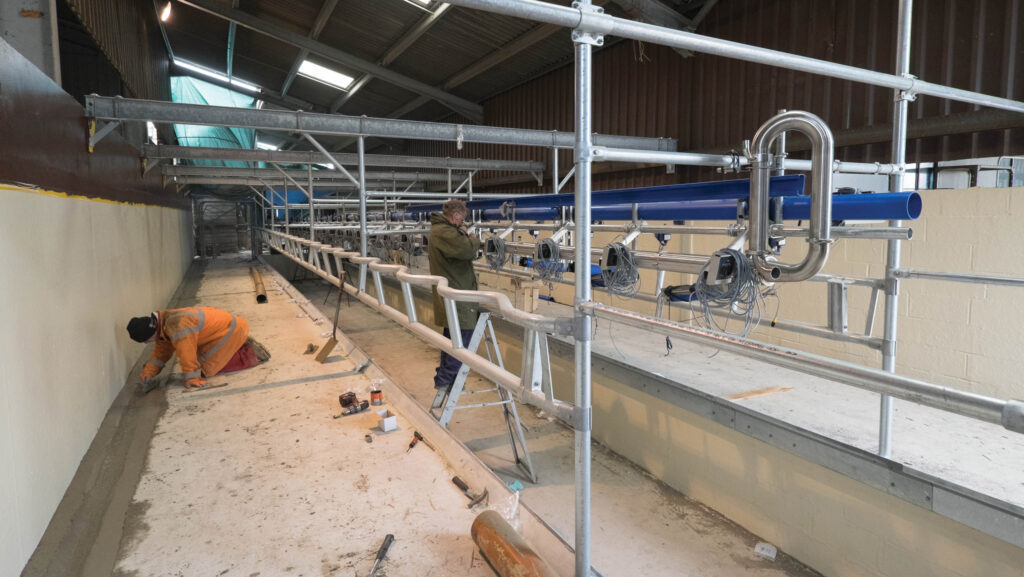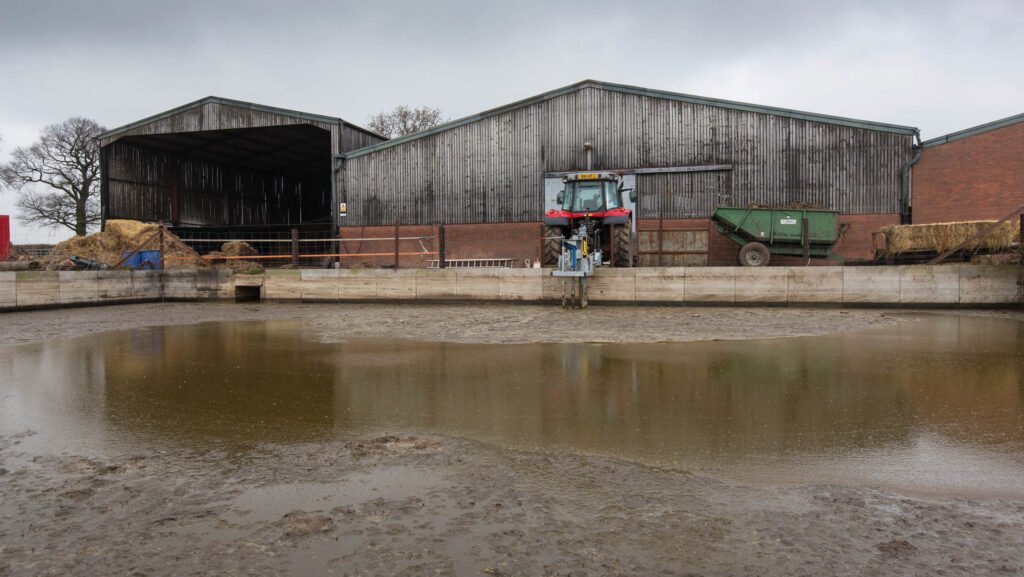7 tips for expanding your dairy herd safely
 A new parlour can increase milking efficiency, putting more money in the tank © Tim Scrivener
A new parlour can increase milking efficiency, putting more money in the tank © Tim Scrivener Over the past two decades, the average UK herd size has more than doubled, and consultants say more dairy farmers are looking to expand to “stay in the game” amid rising costs.
This trend will continue, believes farm consultant Sarah Lea from P&L Agri Consulting, as farmers fight to keep up with inflation and dilute fixed costs by spreading them over more litres of milk.
“When looking at our data set of fully costed farms up to the end of March 2024, variable costs haven’t really changed, but overheads like insurance, electricity, labour and finance have rocketed. These are the costs farmers have very little control over.”
See also: How self-feed silage allowed autumn-block herd to expand
Sam Evans Associates partner Sam Evans says expansion is also partly being driven by the next generation.
“If family members are returning home, the business often needs to increase output, to justify additional drawings. Others are growing to stay in the game,” he says.
However, underestimating the cost of the project or not putting milk in the tank quickly enough can starve the business of cash.
Sarah and Sam, along with Kingshay’s senior farm services manager, Kathryn Rowland, offer advice on how to scale up safely.
1. Why expand?
The first question to ask is what the reason is for expansion.
Sam says: “Is it because you believe you’re not big enough, or you are not making enough money? Sometimes, people try to mimic farmers they believe are successful rather than doing what they [themselves] are good at.”
He says technical and financial efficiencies should be targeted first before adding more cows: “It is hard to expand a business under stress, and the risks are greater.”
Farmers should also look carefully at projected returns. “If you need to spend £250,000, for example, are you happy the returns are enough, or would you be better investing elsewhere?
“I’ve had clients who have invested in a poultry unit instead or converted barns into rental properties. But it is imperative you have the skill set to diversify,” Sam advises.
2. Check demand for extra milk
Before creating a budget, check if the farm’s milk processor will collect the extra milk.
“It is very important to consider seasonality and how that will affect your returns, especially if you are on an aligned contract. You may not get paid your current price on any additional litres,” warns Sam.
3. Budget and assess borrowing options
Base budgets on current milk prices and milk output but build in scenarios that show the business plan has been stress tested. Also, compare how these budgets perform against the milk price for the past three years.
Such sensitivity analysis should include assessing what would happen if the milk price dropped or feed prices increased, for example. Extra running costs and additional labour should also be accounted for.
Most banks typically have a maximum of 60-70% loan to value.
For example, if buying land that is worth £10,000/acre, they will lend £6,000-£7,000. “Some will only lend on historic performance, while others will lean on the business plan you provide,” says Sam.
Fundamentally, banks will look at the farm’s ability to service existing and new debt.
Sarah says farmers should not be afraid to look at short-term finance from secondary lenders to buy cows: “Generally, it is easier – quicker to get the money and the rates can be just as competitive as banks.”
Kathryn says a budget should include a five-year cashflow projection based on current cost of production.
“Cashflow can kill a business. The most complex challenge is predicting what the milk price will do, but output costs are not likely to come down.
“It might be better to get a third party involved with a fresh pair of eyes that can produce a professional report for the bank,” she suggests.
If things are not looking rosy, other areas may need to be improved.
“Sometimes, expansion is not the answer, and farmers need to make better use of their current resources.
“There are a lot of smaller herds that are just as efficient and profitable as larger ones,” she adds.
She advises doing a comprehensive budget to help draw out these answers.
4. Determine infrastructure requirements
Many dairy farms have added cows in the past and got away without increasing slurry and silage infrastructure.
“Farmers have typically focused on investing in cow housing to put more milk in the tank. Investing in compliance sometimes only delivers a return if you don’t receive a pollution fine,” explains Sam.
However, with environmental bodies now cracking down on farms that are not meeting slurry and silage storage rules, he says it is critical to ensure existing and new infrastructure is compliant with current regulations.
In some areas, farms may be able to export slurry to neighbouring arable or beef and sheep units.
See also: 6 ways to prepare for tighter slurry regulations
An assessment of dry cow accommodation and calf housing is also essential: “You must think about the whole life cycle of that cow. When you overstock dry cow sheds and calves, it can be a disaster because it can create disease issues,” says Sarah.
She encourages block calvers to make the best use of existing facilities: “Could you empty an indoor silage clamp and use that for calving yards, or buy straw just in time to free up a shed? If you are on a grass system, could you outwinter heifers?”
Polytunnels, calf units or hutches are cost-effective options to consider alongside contract-rearing to free up space for milking cows.

Farms planning to expand must remember to increase slurry capacity © Tim Scrivener
5. Source extra cows carefully
Buying in is often a quicker way to put milk in the tank but poses disease risks. Sam advises speaking to the farm vet to limit these risks.
“Buying from [only] one herd that mimics your production and cow type will limit disease, make it much easier, and save time,” he says.
If breeding replacements on farm, Sarah says timescales should not be overlooked.
“If you breed the cows yourself, there can be a three-year time lag before milk enters the tank.
“You need to budget for that and ensure you can withstand it from a cashflow point of view because you won’t be bringing in extra income straightaway to pay for the infrastructure,” she cautions.
She says it is also important to factor in that heifer yields are, on average, 10% lower than mature cows. This will affect initial milk sales.
6. What about extra grazing and silage?
It is generally easier for high-yielding dairies to expand. This is because they can buy feed in and have higher output from each cow to cover the investment.
“That’s why they are increasing at such a rate,” says Sarah, who adds: “Once farms get to 500-600 cows, they get can good economies of scale and dilution of overheads.”
Grazing restricts expansion, which is why block calvers often take on another site, she explains.
Outsourcing heifers or silage making can free up space for more milkers on the grazing platform, but improving grassland performance through soil testing and reseeding should not be neglected.
“On a block-calving system, the most dangerous scenario is increasing stocking rates too much and having to feed more cake or silage.
“With extreme weather conditions and varying land type and grass production, it is about finding the right pinch point for your farm,” she says.
7. Calculate staffing needs
It is a good idea to review efficiencies before estimating how many extra pairs of hands are needed.
Moving to 10-in-seven milkings or self-feed silage might be good options for block-calving herds.
Meanwhile, housed units should utilise automisation to reduce labour requirements.
Sarah adds: “Look at different ways of employing staff. Gone are the days of general farm workers: people want specific roles or shift work, so look at how you could accommodate that.
“Asking people to work shorter hours also avoids burnout.”
Pitfalls to avoid
- Building timescales often overrun, which can put pressure on stocking rates, extend the grazing season and limit milk output
- Resist the temptation to give builders extra jobs; instead, factor these in at the start and be realistic about timescales to avoid going over budget
- Cow costs can change quickly – speak to your bank promptly if you require more money
- Do not underestimate how many cows are needed to pay back debt
The numbers
- 35,741 Number of registered dairy holdings in 1995
- 7,130 Producer numbers as of April 2024
- 97 Average UK herd size in 2004
- 219 Average UK herd size for the year ended March 2024
Note: Cow numbers have stayed relatively static at 1.8m since 2014 and milk yield has increased from less than 6,000 litres a cow a year to more than 8,000 litres.
Sources: AHDB Dairy and Kingshay Consultants
